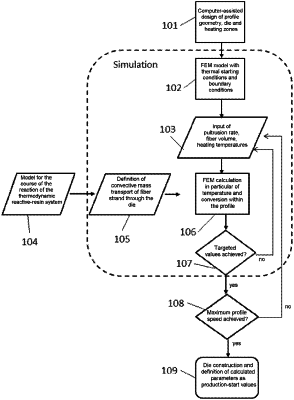| CPC B29C 70/523 (2013.01) | 7 Claims |

|
1. A pultrusion method for the production of fiber-reinforced plastics profiles based on continuous fibers, on continuous-fiber bundles or on semifinished textile products, and on a liquid reactive-resin mixture, comprising:
i) drawing continuous fibers, continuous-fiber bundles or semifinished textile products through an injection box or a resin bath,
ii) charging, into the injection box or the resin bath, the liquid reactive-resin mixture to saturate the continuous fibers, the continuous-fiber bundles or the semifinished textile products,
iii) drawing the saturated continuous fibers, continuous-fiber bundles or semifinished textile products from the injection box or the resin bath into a chamber of a temperature-controllable die for the exothermic hardening of the reactive-resin mixture to form of the fiber-reinforced profile, and
iv) drawing the fiber-reinforced profile out of the chamber, wherein
a) in at least one preliminary experiment, the components of the reactive-resin mixture are mixed at a start temperature T0 at a time t0, and at at least two further times t1 and t2 corresponding temperatures T1 and T2 are determined, and also reaction conversions r1 and r2 are determined during the exothermic reaction of the components in the reactive-resin mixture,
b) the measured values determined in a) are utilized for the determination of the parameters of a prescribed thermodynamic calculation model which describes the time-related changes of temperature and reaction conversion for any desired starting conditions for the reactive-resin mixture used,
c) the exothermic curing method described in step iii) is simulated in finite element method simulation software with the parameters determined in b) and with the thermodynamic calculation model and with the geometric data of the plastics profile and of the pultrusion die,
d) the simulation carried out in c) is used in an iterative method to determine optimized die temperatures at the entry into the chamber and in further sections of the chamber, said temperatures permitting the highest possible output rate while complying with prescribed quality features, and
e) the pultrusion is carried out with use of the optimized die temperatures in the chamber.
|